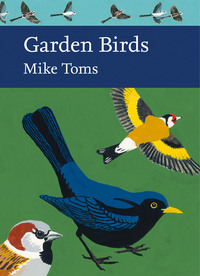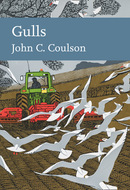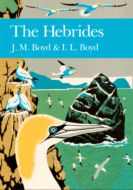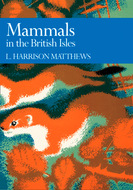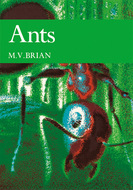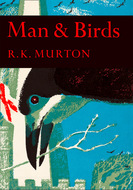Raamatut ei saa failina alla laadida, kuid seda saab lugeda meie rakenduses või veebis.
Loe raamatut: «Garden Birds»

Copyright
William Collins
An imprint of HarperCollinsPublishers 1 London Bridge Street London SE1 9GF WilliamCollinsBooks.com This eBook edition published by William Collins in 2019 Copyright © Mike Toms, 2019 Photographs © Individual copyright holders Mike Toms asserts his moral right to be identified as the author of this work Cover art by Robert Gillmor A catalogue record for this book is available from the British Library. All rights reserved under International and Pan-American Copyright Conventions. By payment of the required fees, you have been granted the non-exclusive, non-transferable right to access and read the text of this eBook on-screen. No part of this text may be reproduced, transmitted, downloaded, decompiled, reverse engineered, or stored in or introduced into any information storage and retrieval system, in any form or by any means, whether electronic or mechanical, now known or hereinafter invented, without the express written permission of HarperCollins Publishers. Source ISBN: 9780008164744 Ebook Edition © April 2019 ISBN: 9780008164768 Version: 2019-04-03
THIS BOOK IS DEDICATED
TO CHRIS MEAD AND DAVID GLUE,
WHOSE KNOWLEDGE OF GARDEN BIRDS
AND PASSION FOR THEIR STUDY, IS MUCH MISSED.
EDITORS
SARAH A. CORBET, SCD
DAVID STREETER, MBE, FIBIOL
JIM FLEGG, OBE, FIHORT
PROF. JONATHAN SILVERTOWN
PROF. BRIAN SHORT
*
The aim of this series is to interest the general
reader in the wildlife of Britain by recapturing
the enquiring spirit of the old naturalists.
The editors believe that the natural pride of
the British public in the native flora and fauna,
to which must be added concern for their
conservation, is best fostered by maintaining
a high standard of accuracy combined with
clarity of exposition in presenting the results
of modern scientific research.
Contents
Cover
Title Page
Copyright
Dedication
About the Editors
Editors’ Preface
Author’s Foreword and Acknowledgements
1 Gardens and Birds
2 Foods and Feeding
3 Nests, Nest Boxes and Breeding
4 Opportunities and Risks
5 Behaviour
6 Birds, Gardens and People
7 Species Accounts
References
Species Index
General Index
The New Naturalist Library
About the Author
About the Publisher
Editors’ Preface
GIVEN THE EXPLOSION OF INTEREST in garden birds, their habits and feeding since the 1960s, this is an addition to the New Naturalist Library that was crying out to be written. Many, perhaps most of us, are familiar with a range of garden birds on a day-to-day basis. That range may be large or small, but familiarity engenders an interest in how the birds are faring and an enthusiasm for taking part in censuses and surveys: ideal seeding ground for what are now called citizen science projects. Against this background, the Editorial Board was fortunate to be able to call on an author tailor-made for the task in Mike Toms. Mike will be familiar to NN readers as the author of the very popular and very readable text on owls (NN 125, 2014). He has spent most of his working life with the British Trust for Ornithology. Over and above his personal fascination with owls, he has been involved in the organisation and analyses of the various BTO Garden Bird studies and, thus, is the ideal author for this authoritative text.
The text opens with an analysis of the role of gardens in the ecology and general prosperity of our commoner land bird populations and an assessment of the diversity that we have created. Interestingly, though we think of gardens as ubiquitous, the land area that they occupy, at just over 400,000 ha, is only slightly larger than the county of Suffolk, and less than 10 per cent of British land area with some form of statutory protection. That said, the potential for interest and fascination that they offer, far outweighs those statistics. In the second chapter, Mike Toms explores the phenomenal growth of garden bird feeding since the end of the Second World War and the equally amazing diversity of foodstuffs now available, particularly seeds. Long gone are the days of throwing out a handful of scraps from the table to satisfy our feathered friends!
Subsequent chapters cover the provision of nesting opportunities, nest boxes and other aspects of the breeding season (Chapter 3), and the aptly-named ‘Opportunities and Risks’ (Chapter 4) outlines the disease health hazards (sometimes devastating) that birds face at feeding stations. Enthusiastic gatherings squabbling at feeders become vulnerable to lurking sharp-eyed predators like Sparrowhawks Accipiter nisus. Chapter 5, ‘Behaviour’, emphasises the opportunities (and privileges) on offer in gardens, to watch birds interacting at close quarters, and demonstrates how simply watching can develop into (equally enjoyable) studying, far more easily than in the general open countryside. Equally absorbing and fascinating are the varied aspects of garden bird watching in Chapter 6, ‘Birds, Gardens and People’, which, among other things, emphasises the many benefits, including to physical and mental health, that people can derive from the interactions.
The last chapter is an extremely useful compendium of succinct accounts of the most regularly observed garden birds, with, in each case, tabulated biological data (clutch size, incubation period, breeding attempts per annum, etc.) followed by an account of the particular relevance of the species to our gardens. It lists, without fear or favour, ‘the good, the bad and the ugly’ of garden birds and items of fascination too numerous to note, other than to offer examples. Few outside the southeast of England would have considered the Ring-necked Parakeet Psittacula krameri as a garden bird, but these raucous and colourful aliens (although now with a self-sustaining feral population) can be a domineering force disrupting the feeding and nesting of other species. The Magpie Pica pica, not a popular garden bird, has its evil reputation as a predator of nests and nestlings accurately assessed, and moderated. Perhaps strangest of all, the Red Kite Milvus milvus – which most of us would consider an unlikely garden bird – is now numerous enough near its centres of reintroduction to visit garden feeding stations routinely, and some populations are showing signs of dietary imbalance, the natural food of carcasses, road kills etc. being substantially better for them than the household waste scraps usually on offer in gardens.
Much else of equal fascination awaits – now please do read on and enjoy Garden Birds to the full.
Author’s Foreword and Acknowledgements
PRIVATE GARDENS PROVIDE OPPORTUNITIES FOR engagement with the natural world, delivering connection with a broad range of different plants and animals. Birds are one of the most obvious and accessible components of the community of species using our gardens, visiting bird tables and hanging feeders, and occupying the nest boxes that we erect for them. Familiar species, like Robin, House Sparrow and Blackbird, provide a common currency, the basis to conversations had between neighbours, relatives and friends. That we choose to engage with garden birds, and talk about their visits and behaviour, underlines the central place that they play in our lives. For those who never venture into the wider countryside, garden birds can provide a window onto the natural world, helping to restore lost connections and contributing to health and well-being. But what about the birds themselves; what role do gardens play in their ecology and behaviour? What do we really know about the risks and benefits that shape how and why birds use gardens and the resources present within them?
Over the past two decades, I have been fortunate enough to have worked on garden birds, and with those who chose to watch them in their gardens. Through ‘citizen science’ projects, most notably the weekly BTO Garden BirdWatch scheme, I have been able to study the different ways in which wild birds use our gardens. I have been able to examine garden use in relation to the wider landscape, exploring both the seasonality of garden use and the longer-term patterns that have followed changes in how we manage the countryside. Thanks to the efforts and support of the volunteers participating in citizen science schemes, I have been able to explore some of the questions surrounding garden use and the role that gardens and their resources play in the lives of visiting birds, addressing the benefits of food provision, the risks of disease transmission and the threats posed by predatory species.
Such research underlines that the ecological processes operating within the garden environment are similar to those operating elsewhere, providing us with opportunities to learn about the wider world and to recognise the role that gardens play within the broader suite of habitats that make up our countryside. Gardens and the wider built environment pose some particular challenges for wild birds; they also offer unique opportunities. The process of urbanisation means that more land will be occupied by urban landscapes and we need to understand the implications of this if we are to deliver built environments that can also work for birds and other wildlife, rather than just for ourselves. Much of the work outlined in this book, carried out by researchers around the globe, delivers the scientific evidence and understanding that we will need as we seek to inform decision-makers and support conservation practitioners. I am fortunate enough to have played a small part in this work, and I hope that reading about it excites you as much as it excites those of us carrying out the research and citizen science.
This book would not have been possible without the help, support and generosity of many people. In particular I would like to thank those with whom I have been fortunate enough to have worked on garden birds: Margaret Askew, Andrew Cannon, Dan Chamberlain, David Glue, Tim Harrison, Donna Hobbs, Becky Lawson, Dave Leech, Amy Lewis, Chris Mead, Kate Plummer, Jacky and Alic Prior, Kate Risely, Clare Simm, Gavin Siriwardena and Paul Stancliffe. I am most grateful to Myles Archibald, Hazel Eriksson, Julia Koppitz and the staff at William Collins; to Jim Flegg and the New Naturalist Editorial Board, and to Tom Cabot for his work on design and layout. Once again, I have been extremely fortunate to have my words graced by cover artwork produced by Robert Gillmor. The photographs that grace this book and bring the text to life were very generously and kindly provided by Mark Grantham, John Harding, Jill Pakenham, Hazel Rothwell, Tom Streeter and Moss Taylor, to all of whom I am very grateful. Thanks are also due to the staff of the BTO, its volunteers and those who have supported the work on garden birds through projects like Garden BirdWatch. The BTO, its staff and volunteers are truly inspirational and I am very grateful to have found such a wonderful place of employment. Finally, I would like to thank Annabel Hill for her love and support, and for helping to make this book possible.
Mike Toms
November 2018
CHAPTER 1
Gardens and Birds
PRIVATE GARDENS ARE A FEATURE of most of the dwellings found within the UK. A study by Davies et al. (2009), using data from a number of different datasets, put the proportion of households with an associated garden at 87 per cent. The researchers then used this information, alongside figures for mean garden size and the number of households, to calculate the total area of gardens within the UK. The resulting figure, some 432,964 ha, represents an area larger than the county of Suffolk but still an order of magnitude less than the 4.7 million ha of UK land that is under statutory protection.
While such figures underline that gardens only make up a relatively small part of the UK land area, they are the habitat within which many of us engage with birds and other forms of wildlife. This gives them special importance, not least because gardens provide the best opportunities to empower UK citizens with the conservation and research understanding needed to support sustainable planning, lifestyle and land management decisions. Birds are of particular importance in this context because they are one of the most visible, accessible and appreciated components of the wider natural world. If we can understand how they use gardens, and how this use is perceived by the people who have access to those gardens, then we can begin to provide the evidence and messaging needed to support public engagement with the natural world more widely.

FIG 1. Private gardens vary considerably in their size, composition and use, presenting a series of different opportunities for birds. (Mike Toms)
We also need to recognise that gardens come in many different forms; at the simplest level they have tended to be split into those that are urban, suburban or rural in nature, but there is substantial variation within these broad categories. Many gardens fall within urbanised landscapes, so we also need to understand the relationships that exist between gardens and their surroundings. We know, for example, that city-centre gardens are just one form of urban green space and that birds, being mobile, will move between a city’s many different patches of such space. But how important is the spatial arrangement of these different patches or the temporal pattern of feeding resources available within them? Many of the same questions can be asked of those birds using rural gardens, perhaps bordered by arable farmland or woodland plantations. This underlines that gardens should not be viewed in isolation but rather as a part of a wider landscape over which birds may range. In some cases these ranging movements may take birds not just beyond the boundaries of the gardens and often urbanised landscapes within which they sit, but also beyond the borders of countries or even continents.

FIG 2. The Robin is perhaps the most familiar of our ‘garden birds’ but in reality it is a species of woodland edge habitats. (John Harding)
It is for this reason that this book on garden birds starts by looking at the nature of the garden habitat and the garden’s place within a wider landscape context. Inevitably, this will require us to look at urban ecology and the processes that shape the urban environment, and to look into a future where the ongoing process of urbanisation sees an ever-growing number of us living within towns and cities. We will also use this chapter as an opportunity to ask ‘what is a garden bird?’ and to examine the nature of garden bird communities. Are they, for example, just those species that happen to be generally common and widespread across the wider landscape, or is there something special about garden bird species and the communities that they form.
THE URBAN ENVIRONMENT
One of the most shocking statistics relating to the human population is that showing the proportion of the global population now living within urbanised landscapes (see Figure 3); this figure, which passed 50 per cent in 2008, is projected to reach 66 per cent by 2050 (United Nations, 2014). This increase brings with it an associated increase in the amount of land under urban cover. Urbanisation is an ongoing process and considered to be one of the greatest threats facing species and their ecosystems. It is of particular concern because some of the most intensive urban development is projected to occur within key global biodiversity hotspots (Elmqvist et al., 2013). The growth in the numbers of households globally, and within biodiversity hotspot regions in particular, has been more rapid than aggregated human population growth, reflecting that average household size continues to fall. This is relevant because the reduction in average household size is thought to have added 233 million additional households to biodiversity hotspot countries alone between 2000 and 2015 (Liu et al., 2003). It seems all the more important than ever to understand the implications of urbanisation for biodiversity; to some extent this urgency has been recognised by the research community, with increasing numbers of studies helping to unravel how birds and other forms of wildlife make use of the urban environment and revealing what urban expansion means for their wider populations. Urbanisation also has implications for the ways in which the human population interacts with the wider natural world, of which it is a part, so we also need to learn about these relationships and what they mean for both birds and people; this is something that we will explore in Chapter 6.

FIG 3. The proportion of the human population living within urbanised landscapes passed 50% in 2008 and is predicted to reach 66% by 2050. Redrawn from United Nations data.
The process of urbanisation involves the conversion of natural or semi-natural landscapes – the latter including farmed land – into ones that are characterised by high densities of artificial structures and impervious surfaces. Urbanised landscapes contain fragmented and highly disturbed habitats, are occupied by high densities of people and show an elevated availability of certain resources. Associated with the process of urbanisation is the modification of ecological processes, particularly those linked with nutrient cycling and water flow. The density of bird species within such landscapes is best explained by anthropogenic features and is often negatively associated with the amount of urban cover. This underlines the importance of urban green space, especially gardens and (for some species) urban parks and woodland. Although many bird species decline in abundance once an area has become urbanised, some are able to take advantage of the new opportunities that have been created. Because different species respond to urbanisation in different ways, we typically see a dramatic shift in the structure of avian communities living within urban landscapes and the habitats, like gardens and urban parks, found within them.
Alongside the structural changes seen, which may alter nesting opportunities or the availability of food resources, urbanisation also results in increased levels of disturbance, noise, night-time light and pollution, all of which may impact birds and other wildlife. While some of these impacts may be generally negative across species, there may be instances where such effects are not felt equally. Noise pollution can impact on some species more than others, for example, perhaps because of the frequencies at which such noise tends to occur; bird species whose songs are pitched towards lower frequencies may be affected more than those whose high-pitched songs can still be heard above the background noise. Other species may show a behavioural response, perhaps moving the time at which they sing or even altering the characteristics of the song itself. It has been found, for example, that Robin Erithacus rubecula populations breeding in noisy parts of urban Sheffield sing at night, with the levels of daytime noise experienced by these individuals a better predictor of their nocturnal singing behaviour than levels of night-time light pollution, the latter previously considered to have been the driver for nocturnal song in this species (Fuller et al., 2007a).
Not all of the changes that occur during urbanisation are necessarily negative; the provision of food at garden feeding stations (Chapter 2) is regarded as being generally beneficial, buffering the temporal variation in food availability that is typical of natural landscapes and thought to limit populations. The availability of anthropogenic food, either at garden feeding stations or present as food scraps, is thought to be one of the main factors driving the structure of urban bird communities, something to which we will return shortly. A number of studies have found that urbanisation stabilises both the richness and composition of bird communities, perhaps because there is greater predictability of, and less variation within, the climate and resource availability of more urbanised landscapes (Suhonen et al., 2009; Leveau & Leveau, 2012).
As we’ll also discover later in this chapter, some species are better able to cope with or respond to the impacts and opportunities of the built environment than others, and there are particular traits within bird families or species groups which may lead to them being more likely to adapt to the urban environment (Blair, 1996). This raises the question of just what is a garden bird.
WHAT IS A GARDEN BIRD?
Some people take the term ‘garden bird’ to mean a species that is common and widespread, adaptable and found just as commonly in other habitats. While this is certainly true of many garden birds, it is not true of every species found to use gardens on a regular basis. The phrase ‘common or garden’ – meaning something that is common and consequently of little value – may have also added to the sense that garden birds have little conservation value and are thus of little interest. This may be exacerbated by the sense that gardens themselves are an artificial habitat, highly modified and managed and thus greatly removed from more natural habitats and processes. However, it needs to be remembered that many of the habitats that we consider to form the countryside – such as farmland and woodland – are also often highly managed and very different to wholly natural landscapes untouched by human activities. Once we recognise this, then it becomes possible to accept garden birds less as a distinct type of bird and more as simply a subset of a wider population using a broad range of habitats.
Look at any book on UK garden birds and you will see species that are summer migrants (Swift Apus apus, House Martin Delichon urbicum, Spotted Flycatcher Muscicapa striata), winter visitors (Redwing Turdus iliacus, Waxwing Bomybycilla garrulus, Brambling Fringilla montifringilla, Fieldfare Turdus pilaris), insectivores (Goldcrest Regulus regulus, Wren Troglodytes troglodytes), omnivores (Carrion Crow Corvus corone), cavity nesters (Blue Tit Cyanistes caeruleus, Great Tit Parus major) or have low dispersive ability (House Sparrow Passer domesticus), all underlining the variety of ecological traits encountered within our garden bird community. Certain ecological traits may come to the fore if you look at particular components of the wider community; for example, an examination of the birds using garden feeding stations may suggest the dominance of granivorous and omnivorous species rather than insectivores, a reflection of the types of food being provided (Shochat et al., 2010). A different pattern may be seen in winter from summer, when looking at some aspect of the breeding community, or indeed when looking at the same component (e.g. cavity-nesting) but in different geographical locations. We know, for example, that cavity-nesting species are well represented within the UK garden bird community, having adapted to nest boxes, but are far less common in that of Australia, where native cavity nesters rely on natural tree cavities rather than boxes (Shanahan et al., 2014).
Globally, certain species are well represented within garden bird communities, including Rock Dove/Feral Pigeon Columba livia, House Sparrow and Starling Sturnus vulgaris (Aronson et al., 2014). Also widely represented – at least within the wider urban environment – are introduced or ‘invasive’ species such as Mallard Anas platyrhynchos, Canada Goose Branta canadensis, Collared Dove Streptopelia decaocto and Ring-necked Parakeet Psittacula krameri, plus (in those places beyond their native range) House Sparrow, Starling and Rock Dove/Feral Pigeon. As a group, corvids appear to be well represented, as do pigeons and doves, leading some authors to suggest that urban bird communities globally are becoming more homogenous in their composition (either directly, in terms of particular species, or indirectly, through different species occupying similar ecological niches). This process is something that we will discuss in the next section.

FIG 4. Blackbird is best considered as an ‘urban adopter’, a species that is opportunistic in the way that it uses gardens and the resources that they offer. (John Harding)
The species of birds associated with the urban environment – of which gardens are a key component – can be divided into three main types. These are the ‘urban exploiters’, the ‘urban adopters’ and the ‘urban relicts’. Exploiters are those species, like Feral Pigeon, that are typically abundant within urban areas and which depend upon the anthropogenic resources available within the built environment. Adopters also make use of the resources but are more opportunistic in how they do this, and many of our familiar garden birds can be regarded as being of this kind – think of the Blackbirds Turdus merula and Siskins Spinus spinus that move into gardens during the winter months. Urban relict species are those whose population has managed to hang on within a fragment of their former habitat that is now contained within a wider urbanised landscape; such species tend to be found outside of western Europe, where new cities have emerged quickly within formerly wildlife-rich habitats. Another term that may be encountered when discussing urban bird populations is ‘urban avoiders’, those species that are absent or very poorly represented within the urban bird community.
The Rock Dove/Feral Pigeon is one of the oldest and most cosmopolitan commensal species, whose huge global population reflects early domestication and the subsequent transportation and introduction to sites across the world. The very high Feral Pigeon densities encountered in many cities is, to a large degree, a consequence of supplementary feeding and discarded human food, and the presence of buildings and other structures with an abundance of suitable nest sites. In some cities, such as Singapore, these populations are derived from the rapid expansion of a genetically homogenous group of founder individuals (Tang et al., 2018), underlining how a species can very rapidly colonise an urban area given favourable conditions. Similar patterns may be seen in introduced populations of House Sparrow, Starling and Collared Dove.
The notion that species found in a high proportion of the world’s cities, such as Starling, are successful generalists and able to breed anywhere, does require some refinement. Work by Gwénaëlle Mennechez and Philippe Clergeau has, for example, revealed that while the abundance of breeding Starlings does appear to be similar throughout the urbanisation gradient, the degree of urbanisation still has a measurable negative impact on its breeding success. Working in western France, Mennechez and Clergeau (2006) found that the amount of food delivered to Starling nestlings in more urbanised areas was significantly lower than that delivered elsewhere along the urbanisation gradient, resulting in smaller nestling masses. These urban Starlings were found to produce fewer young, each of seemingly lower quality; while they were able to maintain breeding populations in these highly urban habitats, the species was not as successful as a simple measure of breeding abundance might suggest. This is something to which we will return in Chapter 3.
URBAN BIRD COMMUNITIES
Surprisingly perhaps, one in five of the world’s 10,000 or so bird species is found in the highly urbanised landscapes of major cities, including 36 species that have been identified by the IUCN global Red List as threatened with extinction. (Aronson et al., 2014). Globally, the species richness of urban bird communities ranges from 24 species to 368, with a global median of 112.5 species (Aronson et al., 2014). As just noted, a number of studies, typically involving work carried out within a single city, have suggested that the process of urbanisation results in urban bird communities that are becoming increasingly similar over time, and dominated by a few key species. This process is known as homogenisation and is thought to come about because urbanisation not only extirpates native species from an area but also promotes the establishment of non-native species capable of adapting to the new conditions (Luck & Smallbone, 2010). Although these new conditions tend to be similar in cities across the world, they do not in themselves promote the same species winners; instead, it is our preference for certain species (transporting them to new settlements) that has resulted in the homogenisation seen at a global scale (McKinney, 2006).
In their review of the bird communities of 54 cities, spread over 36 countries and 6 continents, Aronson et al. (2014) found that cities tended to retain similar compositional patterns within their distinct biogeographic regions. While certain non-native species were shared across many of the cities studied, the urban communities had not yet become taxonomically homogenised at a global scale – they retained the characteristics of their local region pool. Four species were found in more than 80 per cent of the cities examined; these being the familiar Feral Pigeon, House Sparrow, Starling and Barn Swallow Hirundo rustica. With the exception of Australasia, the proportion of non-native species found within each urban community was similar (at 3 per cent), Australasia being somewhat higher because of the large number of non-native species introduced into New Zealand by settlers. Work within Europe (Jokimäki & Kaisanlahti-Jokimäki, 2003; Clergeau et al., 2006) suggests that urbanisation here might bring about homogenisation by decreasing the abundance of ground-nesting species and those preferring bush-shrub habitats, but also noting that it is difficult to generalise because of the effects of latitude and diversity in the urban habitats studied.
